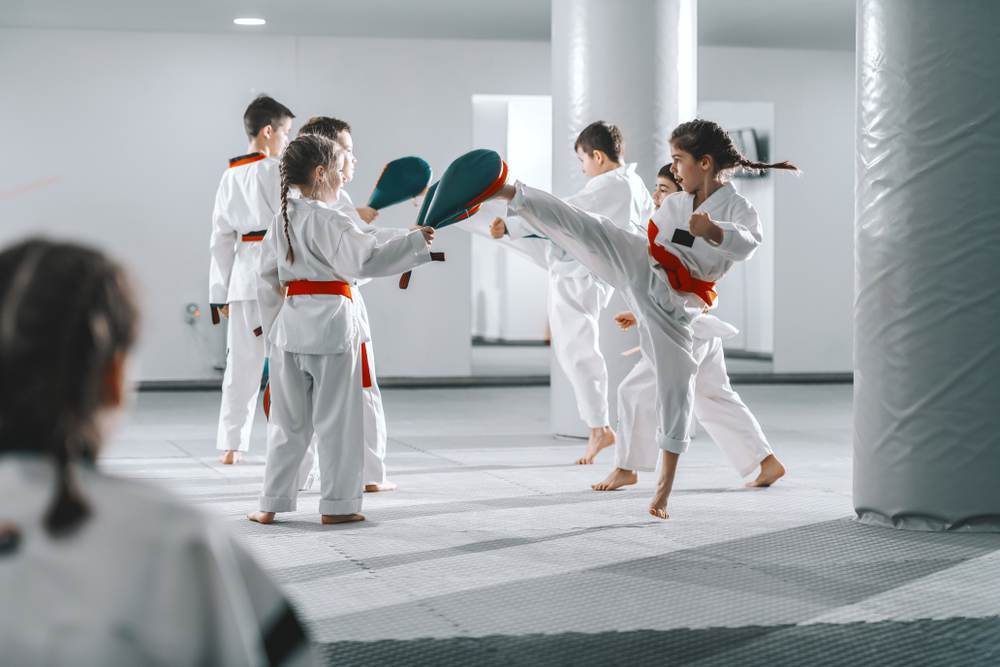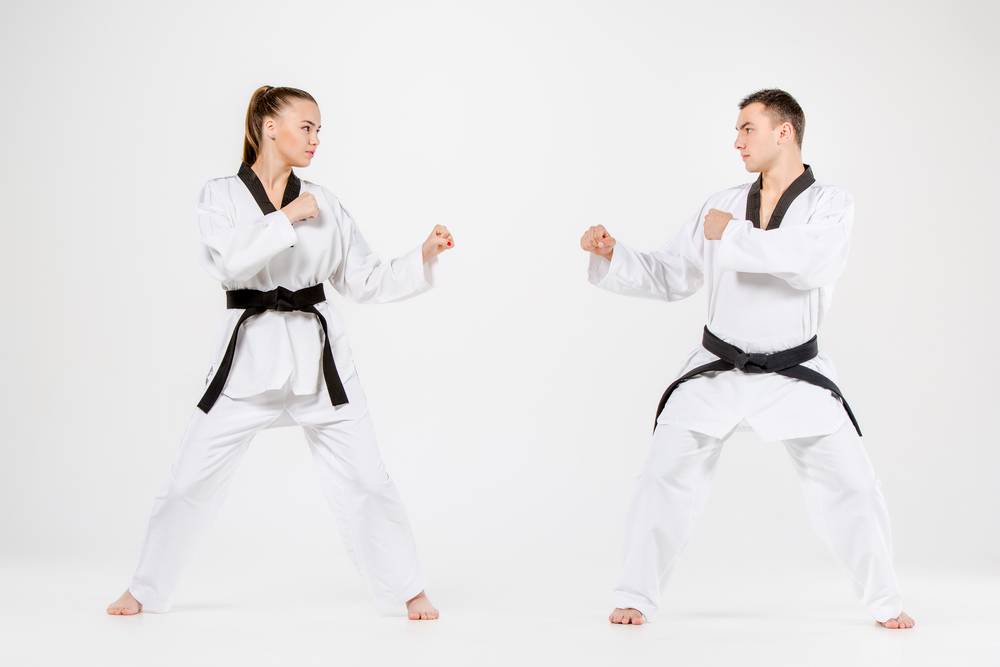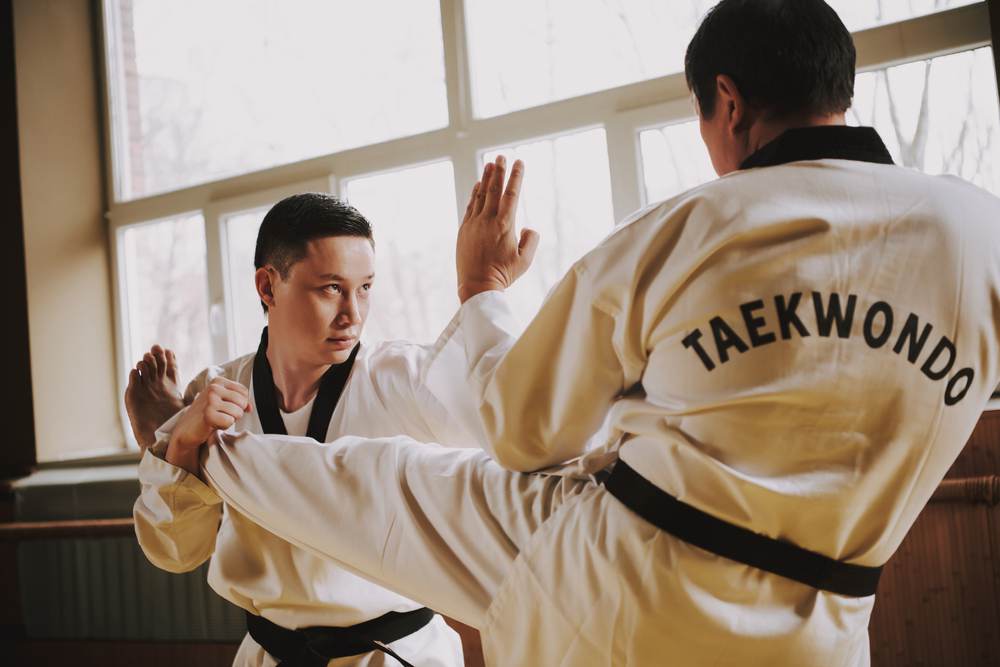Rules of Taekwondo
Ring Dimensions
For all Tae Kwon Do competitions, the dimensions of the contest are to measure ten meters.
The surface of the competition area must be flat and covered with WT-approved foam padding or wood.

Uniform and Safety Equipment
All contestants are required to wear a clean, WT-approved uniform in good condition.
Contestants are also required to wear WT-approved headgear, chest protectors, and forearm and shin pads. Men must wear a protective groin cup.
Only the headgear and chest protectors may be worn outside of the uniform. All other protective paddings must be worn inside the uniform.
To differentiate between competitors in the ring, one will wear a red (hong) chest protector and the other will wear a blue (Chung) chest protector.
Competitors are expected to keep both themselves and their uniforms clean. Unsatisfactory personal hygiene will result in the disqualification of the violator.
Nails must be cut short (both hand and foot). Long hair must be securely tied back.
Metal objects (jewelry) and eyeglasses may not be worn during the competition.
A maximum of two layers of tape is permitted in the case of injury when the tournament physician approves its use.
Competitors may not wear a splint or a cast.
The use of non-prescribed drugs or intoxicants by competitors either before or during a match will result in the disqualification of the violator.
Valid Targets
The only targets allowed in the competition are on the front of the body between the competitor’s waist and the base of the neck, but not the throat itself.
The only body surfaces that can be used to score points are the forefist (open-handed techniques are prohibited) and any part of the foot below the ankle.
Hand techniques may not be directed to the face, however, foot techniques are permitted to the head.
For junior divisions (ages 13–18), kicks to the head must be made with light contact and executed with complete control without causing injury or a penalty will be invoked.
Each hit will earn a competitor one point providing that the strike was executed with the proper technique, balance, and power.
In order to score a point, a technique must land against an authorized area of an opponent’s body with sufficient force to cause a visible shock to the body.
Strikes to valid target areas will not be awarded points if the competitor loses balance after completing the attack, if the competitor is holding the opponent during the attack, or if the competitor continues to attack during a clinch.
Strikes to non-target areas will not be awarded points. Depending on the severity of the offense, a competitor may receive a half-point deduction, a full-point deduction, or be disqualified.
Officials
All competitions are to be supervised by the following WT-certified officials: one referee, four judges, at least one juror, a timekeeper, a weigher, and a recorder.
Referee Duties
1. To oversee and control the competition.
2. To inspect all competitors before matches.
3. To provide competition rules, declare the beginning and end of matches, and to give warnings and instructions to competitors.
4. To announce deducted points, announce disqualifications, signal invalid scores, and control all activity in the ring.
5. To oversee the safety of the competitors.
6. To signal stops of the time clock.
7. To collect and submit judges’ scorecards at the conclusion of each match.
8. To provide opinions to juror requests about judges’ decisions.
9. To stop a match (during junior competitions) to consult judges regarding considerations of mismatch and technical knockouts. Such decisions require unanimous agreement by all judges, along with jury verification.
Judge Duties
1. To be positioned at each corner of the competition ring and assist the referee as necessary.
2. To advise the referee of invalid violation calls.
3. To note all warnings, points, rule infractions, and disqualifications on the scorecard.
4. To total scores and indicate match winners on the scorecard.
5. To give completed scorecards to the referee following the end of each match.
Juror Duties
1. To consult with judges and the referee whenever necessary.
2. To review scorecards for consistency, accuracy, and signatures of judges, and to bring questions regarding any of the aforementioned to the attention of the judges and/or referee.
3. To determine the winner of a match based on the scorecards of the judges and referee.
4. To request the replacement of judges or referees when the performance of these individuals is in question.
5. To sign and submit judges’ and referees’ scorecards to the tournament committee in the event of a protest for the rendering of a final decision.
Timekeeper Duties
To start and stop the official clock and the referee’s instructions and to announce the end of official time periods.
Recorder Duties
To keep the official records of the results of each contest.
Weigher Duties
To determine the weight of each competitor in the presence of a designated, certified referee.
Definitions
Knockdown
1. Whenever any part of the body other than the competitor’s feet touches the floor as the result of an attack.
2. Whenever a competitor is caused to stagger as the result of an attack.
3. Whenever a competitor bends over or squats without showing the intention to continue the match.
Knockout
Whenever a contestant cannot continue the match after the referee has completed a count of ten (yol).
Stopped contest
1. Whenever the referee or tournament physician determines that a contestant should not continue.
2. Whenever a competitor’s coach throws a towel to stop the match.
3. Whenever a competitor protests a referee’s call and fails to continue the match within one minute of the referee’s command.
Decisions
The winner of a match is determined after considering each of the following criteria:
1. The disqualification of the opponent.
2. The withdrawal of the opponent.
3. The injury of the opponent due to a valid attack.
4. The knockout of the opponent due to a valid attack.
5. The difference in points.
6. The deduction of points during a match.
7. Considerations of superiority (see below).
8. Referee stops the contest.
Rules Of Superiority
In situations in which the match results in a tie score, the winner will be decided based on considerations of superiority.
The most effective scoring techniques (best single techniques) executed by each competitor are compared and rated according to the following criteria:
1. A technique of sufficient power to result in an eight-count knockdown is considered superior to any other technique.
2. Any foot technique is considered superior to any hand technique.
3. Any jumping kick is considered superior to any standing technique.
4. Any kick to the head is considered superior to any kick to the body.
5. Any counterattack is considered superior to any initiated attack.
6. If the above criteria cannot resolve the tie, the more aggressive fighter is considered superior.

Hi, my name is Godwin. I am a passionate martial artist with black belts in Taekwondo and Karate. I have over 15 years of martial art experience. I created this platform to enable me to help you learn martial art the right way.






